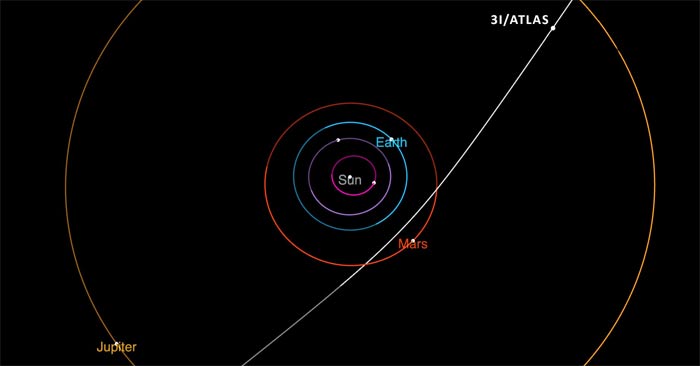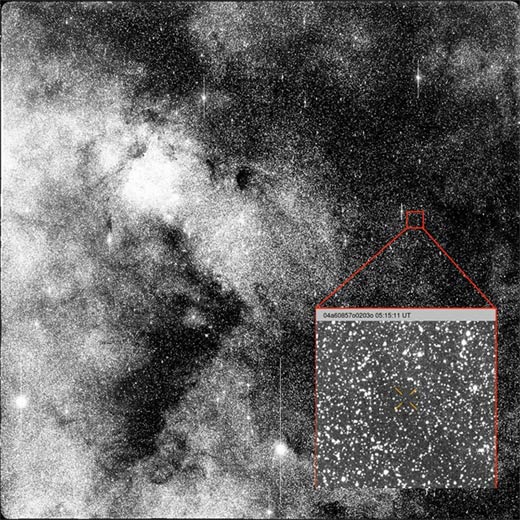What's so special about comet 3I/ATLAS from interstellar space?
Comet 3I/ATLAS is coming from interstellar space and is hurtling through the Solar System at an incredible speed of 60 km/s. Here's what you need to know about this special comet .

Comet 3I/ATLAS is the third known object from outside the solar system. Astronomers have classified the object as interstellar because of its hyperbolic orbit.
Comet 3I/ATLAS poses no threat to Earth and will remain very far away. Its closest approach to our planet will be about 1.8 astronomical units (about 170 million miles or 270 million kilometers). 3I/ATLAS will reach its closest point to the Sun around October 30, 2025, at a distance of about 1.4 au (130 million miles or 210 million kilometers) — just inside the orbit of Mars.
The size and physical properties of the interstellar comet are being studied by astronomers around the world. 3I/ATLAS will remain visible to ground-based telescopes until September 2025, after which it will pass very close to the Sun. It will reappear on the other side of the Sun in early December 2025.
Why is this comet named 3I/ATLAS?
Comets are usually named after their discoverers, in this case the ATLAS survey team. The 'I' stands for 'interstellar', indicating that the object came from outside the solar system. It is the third known interstellar object, hence the '3' in the name.
Where did this interstellar object come from?
3I/ATLAS formed in another star system and was somehow ejected into interstellar space, the space between stars. Over millions, perhaps billions, of years, it drifted until it recently arrived in our solar system. It was approaching in the general direction of the constellation Sagittarius, where the center of our galaxy, the Milky Way, is located. When it was discovered, 3I/ATLAS was about 410 million miles (670 million kilometers) from the Sun, within the orbit of Jupiter.
How was it determined that 3I/ATLAS did not originate from the solar system?
Observations of the comet's orbit show that it is moving too fast to be bound by the Sun's gravity and that it is on what is known as a hyperbolic orbit. In other words, it is not following a closed orbit around the Sun. It is simply passing through the solar system and will continue its journey into interstellar space, never to be seen again.
How many interstellar objects have been discovered?
It is the third known interstellar object. In 2017, 'Oumuamua became the first interstellar object to be discovered; the second, 2I/Borisov, was discovered in 2019.

How big is 3I/ATLAS and is it an asteroid or a comet?
Astronomers don't yet know how big 3I/ATLAS is, but they can see from their observations that it's active, meaning it has an icy core and a dust cloud (a bright cloud of gas and dust that surrounds a comet as it approaches the Sun). This is why astronomers classify it as a comet rather than an asteroid.
How fast is 3I/ATLAS moving?
Very fast. When it was discovered, the interstellar comet was traveling at about 137,000 miles per hour (221,000 kilometers per hour, or 61 kilometers per second), and its speed will increase as it gets closer to the Sun.
Is there a risk of this interstellar object colliding with Earth?
No. Although the object's orbit takes it into the inner solar system, it won't come close to Earth. As comet 3I/ATLAS moves through the solar system, it won't come closer than 1.6 au (about 150 million miles, or 240 million kilometers) to our planet.
You should read it
- Possible superstar comet Atlas looks like it's breaking up already, astronomers report
- NASA spacecraft nabs stunning view of comet Atlas streaking past the sun
- Trump's US Space Force successfully launches its first national security mission
- Comet Borisov, just the second interstellar object to visit us, is spotted falling apart
- The new Atlas robot can perform movements that are impossible for humans
- Traveling interstellar, the Voyager 1 spacecraft sent back to Earth strange sounds
 Giant planet discovered orbiting a tiny star
Giant planet discovered orbiting a tiny star Supermoon and meteor shower appear together on the full moon night of July
Supermoon and meteor shower appear together on the full moon night of July Earth's Magnetic Field: Origin, Structure and Impact on Humanity
Earth's Magnetic Field: Origin, Structure and Impact on Humanity Does the North Star ever move across the sky?
Does the North Star ever move across the sky? Discovery of an ancient spiral galaxy dubbed the 'monster' of the universe
Discovery of an ancient spiral galaxy dubbed the 'monster' of the universe Scientists explain why Mars has a red surface
Scientists explain why Mars has a red surface